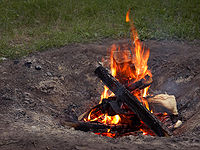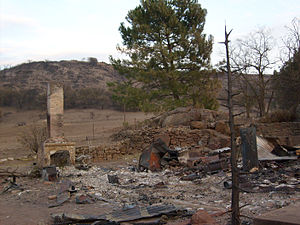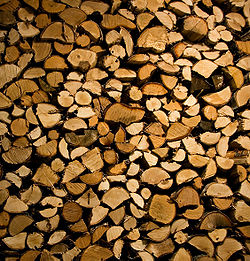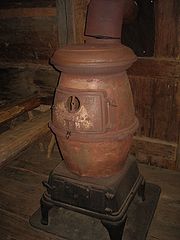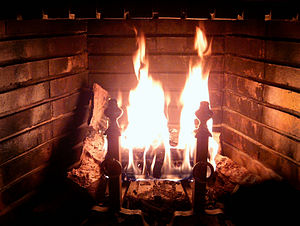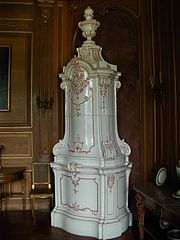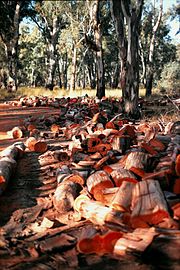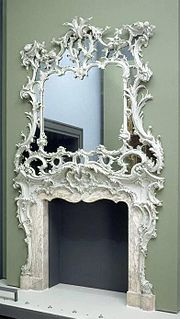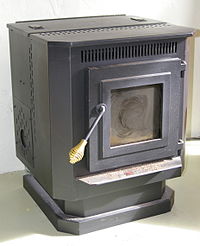
Wood fuel
Background to the schools Wikipedia
Arranging a Wikipedia selection for schools in the developing world without internet was an initiative by SOS Children. SOS Children has looked after children in Africa for forty years. Can you help their work in Africa?
Wood fuel is wood used as fuel. The burning of wood is currently the largest use of energy derived from a solid fuel biomass. Wood fuel can be used for cooking and heating, and occasionally for fueling steam engines and steam turbines that generate electricity. Wood fuel may be available as firewood (eg. logs, bolts, blocks), charcoal, chips, sheets, pellets and sawdust. The particular form used depends upon factors such as source, quantity, quality and application. Sawmill waste and construction industry by-products also include various forms of lumber tailings.
Wood may be burned in a furnace, stove, fireplace, or in a campfire, or used for a bonfire. Wood is the most easily available form of fuel, requiring no tools in the case of picking up dead wood, or little tools, although as in any industry, specialized tools, such as skidders and hydraulic wood splitters, have evolved to mechanize production.
The discovery of how to make fire for the purpose of burning wood is regarded as one of humanity's most important advances.
Historical development
The use of wood as a fuel source for heating is as old as civilization itself. Historically, it was limited in use only by the distribution of technology required to make a spark. Wood heat is still common throughout much of the world.
Early examples include the use of wood heat in tents. Fires were constructed on the ground, and a smoke hole in the top of the tent allowed the smoke to escape by convection.
In permanent structures and in caves, hearths were constructed or established—surfaces of stone or another noncombustible material upon which a fire could be built. Smoke escaped through a smoke hole in the roof.
Wood has been used as fuel for millenia. The Greeks, Romans, Celts, Britons, and Gauls all had access to forests suitable for using as fuel. Domestic fuel and naval duels all ensured the eventual deforestation of Western Europe and the Middle East. The forests of England lasted till the end of the middle ages, when the over-cutting forced the changeover to burning Newcastle coal. Much of the problem was inefficient fires.
The development of the chimney and the fireplace allowed for more effective exhaustion of the smoke. Masonry heaters or stoves went a step further by capturing much of the heat of the fire and exhaust in a large thermal mass, becoming much more efficient than a fireplace alone.
The metal stove was a technological development concurrent with the industrial revolution. Stoves were manufactured or constructed pieces of equipment that contained the fire on all sides and provided a means for controlling the draft—the amount of air allowed to reach the fire. Stoves have been made of a variety of materials. Cast iron is among the more common. Soapstone (talc), tile, and steel have all been used. Metal stoves are often lined with refractory materials such as firebrick, since the hottest part of a woodburning fire will burn away steel over the course of several years' use.
The Franklin stove was developed in the United States by Benjamin Franklin. More a manufactured fireplace than a stove, it had an open front and a heat exchanger in the back that was designed to draw air from the cellar and heat it before releasing it out the sides. The heat exchanger was never a popular feature and was omitted in later versions. So-called "Franklin" stoves today are made in a great variety of styles, though none resembles the original design.
The 1800s became the high point of the cast iron stove. Each local foundry would make their own design, and stoves were built for myriads of purposes--parlour stoves, box stoves, camp stoves, railroad stoves, portable stoves, cooking stoves and so on. Elaborate nickel and chrome edged models took designs to the edge, with cast ornaments, feet and doors. Wood or coal could be burnt in the stoves and thus they were popular for over one hundred years. The action of the fire, combined with the causticity of the ash, ensured that the stove would eventually disintegrate or crack over time. Thus a steady supply of stoves was needed. The maintenance of stoves, needing to be blacked, their smokiness, and the need to split wood meant that oil or electric heat found favour.
The airtight stove, originally made of steel, allowed greater control of combustion, being more tightly fitted than other stoves of the day. Airtight stoves became common in the 19th century.
Use of wood heat declined in popularity with the growing availability of other, less labor-intensive fuels. Wood heat was gradually replaced by coal and later by fuel oil, natural gas and propane heating except in rural areas with available forests.
After the 1967 Oil Embargo, many in the United States used wood for the first time. The EPA provided information on clean stoves, which burned much more efficiently.
Firewood
Some firewood is harvested in " woodlots" managed for that purpose, but in heavily wooded areas it is more usually harvested as a byproduct of natural forests. Deadfall that has not started to rot is preferred, since it is already partly seasoned. Standing dead timber is considered better still, as it is both seasoned, and has less rot. Harvesting this form of timber reduces the speed and intensity of bushfires. Harvesting timber for firewood is normally carried out by hand with chainsaws. Thus, longer pieces - requiring less manual labour, and less chainsaw fuel - are less expensive and only limited by the size of their firebox. Prices also vary considerably with the distance from wood lots, and quality of the wood.
Firewood usually relates to timber or trees unsuitable for building or construction. Firewood is a renewable resource provided the consumption rate is controlled to sustainable levels. The shortage of suitable firewood in some places has seen local populations damaging huge tracts of bush thus leading to further desertification.
Energy content
A common hardwood, red oak, weighs 3757 pounds per cord, with an energy content of 24 million BTU per cord, and 16.8 million recoverable BTU if burned at 70% efficiency.
Measurement of firewood
In the metric system, firewood is normally sold by the stere (1 m³ = ~0.276 cords).
In the United States, firewood is usually sold by the cord, 128 ft³ (3.62 m³), corresponding to a woodpile 8 ft wide × 4 ft high of 4 ft-long logs. The cord is legally defined by statute in most states. A "thrown cord" is firewood that has not been stacked and is defined as 4 feet wide x 4 feet tall x 10 feet long. The additional volume is to make it equivalent to a standard stacked cord, where there is less void space. It is also common to see wood sold by the "face cord", which is usually not legally defined, and varies from one area to another. For example, in one state a pile of wood 8 feet wide × 4 feet high of 16"-long logs will often be sold as a "face cord", though its volume is only one-third of a cord. In another state, or even another area of the same state, the volume of a face cord may be considerably different. Hence, it is risky to buy wood sold in this manner, as the transaction is not based on a legally enforceable unit of measure.
In Australia, it is normally sold by the tonne.
Combustion by-products
As with any fire, burning wood fuel creates numerous by-products, some of which may be useful (heat and steam), and others that are undesirable, irritating or dangerous.
One by-product of wood burning is wood ash, which in moderate amounts is a fertilizer (mainly potash), contributing minerals, but is strongly alkaline as it contains potassium hydroxide (lye). Wood ash can also be used to manufacture soap.
Smoke, containing water vapor, carbon dioxide and other chemicals and aerosol particulates, can be an irritating (and potentially dangerous) by-product of partially burnt wood fuel. A major component of wood smoke is fine particles that may account for a large portion of particulate air pollution in some regions. During cooler months, wood heating accounts for as much as 60% of fine particles in Melbourne, Australia.
Slow combustion stoves increase efficiency of wood heaters burning logs, but also increase particulate production. Low pollution/slow combustion stoves are a current area of research. An alternative approach is to use pyrolysis to produce several useful biochemical byproducts, and clean burning charcoal, or to burn fuel extremely quickly inside a large thermal mass, such as a masonry heater. This has the effect of allowing the fuel to burn completely without producing particulates while maintaining the efficiency of the system.
In some of the most efficient burners, the temperature of the smoke is raised to a much higher temperature where the smoke will itself burn (e.g., 1,200 degrees for igniting carbon monoxide gas). This may result in significant reduction of smoke hazards while also providing additional heat from the process. By using a catalytic converter, the temperature for obtaining cleaner smoke can be reduced. Some U.S. jurisdictions prohibit sale or installation of stoves that do not incorporate catalytic converters.
Combustion by-product effects on human health
Depending on population density, topography, climatic conditions and combustion equipment used, wood heating may substantially contribute to air pollution, particularly particulates. Wood combustion products can include toxic and carcinogenic substances. The conditions in which wood is burnt will greatly influence the content of the emission.
Particulate air pollution can contribute to human health problems and increased hospital admissions for asthma & heart diseases.
The technique of compressing wood pulp into pellets or artificial logs can reduce emissions. The combustion is cleaner, and the increased wood density and reduced water content can eliminate 30 to 70% of the transport bulk. Thus the fossil energy consumed in transport is reduced (and in fact represents a tiny fraction of the fossil fuel consumed in producing and distributing heating oil or gas).
Environmental Impact
Harvesting Operations
Much wood fuel comes from native forests around the world. Plantation wood is rarely used for firewood, as it is more valuable as timber or wood pulp. The collection or harvesting of this wood can have serious environmental implications for the collection area. The concerns are often specific to the particular area, but can include all the problems that regular logging create. Removing wood from forests can cause habitat destruction.
Greenhouse gases
Wood burning does not release more carbon dioxide than its biodegradation ( rottening). Wood burning can therefore be called "carbon neutral". Of course, harvesting and transport operations can produce significant amounts of greenhouse gas pollution.
Wood Fuels around the World
European use of wood fuel
Some countries produce a significant fraction of their electricity needs from wood or wood wastes. Sweden, for example produces 1490 megawatts of electricity this way and Austria produces 747 megawatts. The Swedish figure corresponds circa 4.5 % of the nation's total installed production capacity (33 400 MW in 2003). In Finland, there is a growing interest in using wood waste as fuel for home and industrial heating, in the form of compacted pellets.
In Scandinavian countries the costs of manual labour to process firewood is very high. Therefore it is common to import firewood from countries with cheap labour and natural resources. The main exporters to Scandinavia are the Baltic countries (Estonia, Lithuania, Latvia).
Historic Japanese use of wood fuel
Wood, during the Edo period, was used for many purposes, and the consumption of wood led Japan to develop a forest management policy during that era. Demand for timber resources was on the rise not only for fuel, but also for construction of ships and buildings, and consequently deforestation was widespread. As a result, forest fires occurred, along with floods and soil erosion. Around 1666, the shogun made it a policy to reduce logging and increase the planting of trees. This policy decreed that only the shogun, and/or a daimyo, could authorize the use of wood. By the 18th century, Japan had developed detailed scientific knowledge about silviculture and plantation forestry.
Firewood use in Australia
About 1.5 million households in Australia use firewood as the main form of domestic heating. As of 1995, approximately 1.85 million cubic metres of firewood (1m³ equals approximately one car trailer load) was used in Victoria annually, with half being consumed in Melbourne. This amount is comparable to the wood consumed by all of Victoria’s sawlog and pulplog forestry operations (1.9 million m³).
Species used as sources of firewood include:
- Red Gum, from forests along the Murray River (the Mid-Murray Forest Management Area, including the Barmah and Gunbower forests, provides about 80% of Victoria’s red gum timber).
- Box and Messmate Stringybark, in southern Australia.
- Sugar gum, a wood with high thermal efficiency that usually comes from small plantations.
Environmental concerns
In Victoria, red gum is the most popular and commonly used firewood. Although some consider that Victoria's red gum forests are being depleted wholesale as a direct result of firewood harvesting, much of the forest clearance occurred decades ago, when the wood was used in large-scale infrastructure projects such as railway construction.
Victoria and NSW's remnant red gum forests, including the Murray River's Barmah-Millewa forest, are increasingly being clear-felled using mechanical harvesters, destroying ecologically significant and already endangered habitat. Macnally estimates that approximately 81% of fallen timber has been removed from the southern Murray-Darling Basin.
There are concerns with the extent to which firewood harvesting in red gum forests depletes the habitat of various animal species that would otherwise reside in the hollows which form in fallen timber (it is estimated that 37% of mammals and 39% of woodland bird species in Victoria reside in such hollows). In areas where there is extensive firewood harvesting (eg. Barmah), there are concerns that many species may be at risk . The Barmah forest contains 51% of the threatened species found in eastern north Victoria. At least 37 threatened plants are found in Barmah-Millewa, four of which are found nowhere else in Victoria. The forest includes the only remaining Victorian breeding grounds of the Superb Parrot, a bird that is listed as endangered in that state, and as vulnerable on the IUCN Red List. Mammals listed as threatened in both Victoria and New South Wales reside in the forest, including the squirrel glider, the brush tailed phascogale, and the large footed myotis.
Efficiency and sustainability
With appropriately certified and operated modern wood heaters, the use of good quality wood fuel is one of the most efficient and cheapest forms of heating in Australia. The replacement of existing national domestic heating needs supplied by wood, with gas and electricity, would result in a significant net increase in carbon dioxide emissions, while the application and enforcement of national standards for wood heaters and wood fuel would substantially reduce particulate emissions. The peak industry body, the Australian Home Heating Association Inc is a major financial supporter of Landcare Australia, sponsoring the planting of over 40,000 trees per year. Landcare groups have planted millions of trees in revegetation programs to replace the estimated 20 billion trees removed since European settlement, laid thousands of kilometres of protective fencing, introduced sustainable farming techniques, removed hundreds of thousands of tonnes of weeds, and volunteered countless hours to the land care ethic.
Firewood plantations also provide alternative financial opportunities for farmers and local government, with fuel being one of the multi-uses of tree plantations.
1973 energy crisis
A brief resurgence in popularity occurred during and after the 1973 energy crisis, when some believed that fossil fuels would become so expensive as to preclude their use. A period of innovation followed, with many small manufacturers producing stoves based on designs old and new. Notable innovations from that era include the Ashley heater, a thermostatically-controlled stove with an optional perforated steel enclosure that prevented accidental contact with hot surfaces.
A number of dual-fuel furnaces and boilers were made, which utilized ductwork and piping to deliver heat throughout a house or other building.
The growth in popularity of wood heat also led to the development and marketing of a greater variety of equipment for cutting and splitting wood. Consumer grade hydraulic log splitters were developed to be powered by electricity, gasoline, or PTO of farm tractors.
The magazine "Wood Burning Quarterly" was published for several years before changing its name to "Home Energy Digest" and, subsequently, disappearing.
Today
A pellet stove is an appliance that burns compressed wood or biomass pellets.
Wood heat continues to be used in areas where firewood is abundant. For serious attempts at heating, rather than mere ambiance (open fireplaces), stoves, fireplace inserts, and furnaces are most commonly used today. In rural, forested parts of the U.S., freestanding boilers are increasingly common. They are installed outdoors, some distance from the house, and connected to a heat exchanger in the house using underground piping. The mess of wood, bark, smoke, and ashes is kept outside and the risk of fire is reduced. The boilers are large enough to hold a fire all night, and can burn larger pieces of wood, so that less cutting and splitting is required. There is no need to retrofit a chimney in the house. However, outdoor wood boilers emit more wood smoke and associated pollutants than other wood burning appliances. This is due to design characteristics such as the water-filled jacket surrounding the firebox, which acts to cool the fire and leads to incomplete combustion. Outdoor wood boilers also typically have short stack heights in comparison to other wood burning appliances, contributing to ambient levels of particulates at ground level. An alternative that is increasing in popularity are wood gasification boilers, which burn wood at very high efficiencies (85-91%) and can be placed indoors or in an outbuilding.
Wood is still used today for cooking in many places, either in a stove or an open fire. It is also used as a fuel in many industrial processes, including smoking meat and making maple syrup.
As a sustainable energy source, wood fuel also remains viable for generating electricity in areas with easy access to forest products and by-products.

